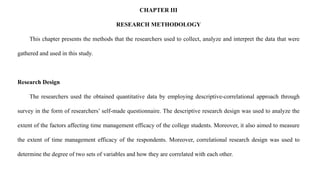
CHAPTER-III.pptx
- 1. CHAPTER III RESEARCH METHODOLOGY This chapter presents the methods that the researchers used to collect, analyze and interpret the data that were gathered and used in this study. Research Design The researchers used the obtained quantitative data by employing descriptive-correlational approach through survey in the form of researchers’ self-made questionnaire. The descriptive research design was used to analyze the extent of the factors affecting time management efficacy of the college students. Moreover, it also aimed to measure the extent of time management efficacy of the respondents. Moreover, correlational research design was used to determine the degree of two sets of variables and how they are correlated with each other.
- 2. Data Gathering Procedures The first step that the researchers did was to ask permission from the dean of the college faculty to conduct the study by means of sending a letter of approval. Meanwhile, the researchers randomly select respondents from the third-year college students. Respondents were oriented and given general directions on what the questionnaire is all about. The purpose of the study was explained to them as well. The researchers administered the questionnaires personally to assist them in answering and clarifying their queries. Upon the retrieval and submission of the questionnaire, data were tallied, computed, analyzed, and interpreted.
- 3. Sampling Technique The sampling technique used by the researchers in this study was a probability sampling technique which was the cluster sampling. Third year college was drawn from the 4 listed year level, which includes 1st year to 4rth year college students at the Sultan Kudarat Islamic Academy Foundation College. Respondents The respondents of this study are the third-year college students of Sultan Kudarat Islamic Academy Foundation College. The researchers had selected 130 out of 196 third year college with various courses. Moreover, sample size calculator was used to determine the ideal sample size with 95% confidence level and 5% margin of error.
- 4. Instrumentation In this study, the following instrument is utilized by the researcher to gather all the data needed to answer the specific problems in this study. Survey Questionnaire. Survey questionnaire is used to describe the set of questions you are asking an individual. In this study, this instrument is used to measure the extent of the learners’ time management efficacy using three indicators namely: Planning, Productivity, and Punctuality which is seen on the second part of the questionnaire as well as the factors affecting it identified by the researchers in terms of activities at home and activities at school that appears on the first part of the survey questionnaire.
- 5. Statistical Treatment The data gathered from the test was carefully recorded in tables, analyzed, and interpreted accordingly based on the results of the statistical treatment. In this study, the researchers used the descriptive statistics such as mean. The mean was used to determine the extent of the factors affecting time management efficacy of the college students and their level of the time management efficacy. In addition, Spearman-rho correlation was also employed to measure the statistical relationship or association between the two variables as well as the direction of the relationship.
- 6. Table 1. Scale on the Interpretation of the Extent of Factors and the Extent of Time Management Efficacy of College Students at the Sultan Kudarat Islamic Academy Foundation College Rating Scale Range of Means Interpretation 5 4.30 - 5.00 Very High 4 3.50 – 4.20 High 3 2.70 – 3.40 Moderat 2 1.90 – 2.60 Low 1 1.00 – 1.80 Very Low Table 1 shows the rating scale, the range of means and the interpretation used by the researchers to measure the extent of the factors and extent of time management efficacy of the college students.
- 7. Table 2. Scale on the Interpretation of the Correlation Coefficient and Strength of Relationship Between the Independent and Dependent Variables Scale and Range Interpretation 0.0 No correlation, no relationship ±0.01 to ±0.20 Very low correlation, almost negligible relationship ±0.21 to ±0.40 Slight correlation, define but small relationship ±0.41 to ±0.70 Moderate correlation, substantial relationship ±0.71 to ±0.90 High correlation, marked relationship ±0. 91 to ±0. 99 Very high correlation, very dependable relationship ±1.00 Perfect correlation, perfect relationship Table 3 shows the scale and range as well as the interpretation used by the researchers to measure the correlation between the investigated factors and the time management efficacy of the college students.